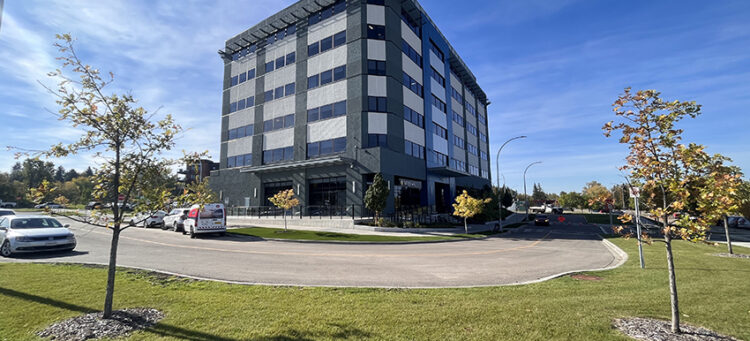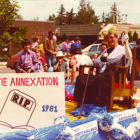
Then & Now
Grandin – Update
By: Dawn Valentine & Gene Kosowan PHOTOGRAPHY: PAULA E. KIRMAN
April, 2024
A mature neighbourhood helped trigger St. Albert’s historic rapid development
Grandin is not only one of St. Albert’s older neighbourhoods, it’s also a district that helped spark a rapid growth spurt in the city. Grandin is also a part of the city that reflects both tradition and progress, as signified by the mid-century modern styles of the original residences and the post-modern buildings that sprung up after. Sandwiched between all those complexes are a number of lush green spaces, adding to the attractive nature of the area.
There’s still much to tell about the neighbourhood, named after Bishop Vital-Justin Grandin, who has recently become a controversial topic himself. The cleric’s changing legacy partly warrants an update of a Grandin story that originally ran in t8n October, 2018.
1950s
St. Albert’s population stood at roughly 1,300 citizens when development began. A year before shovels began turning sod in 1956, the best-known landmark in the area at the time, the St. Albert Drive-In, had just opened immediately south of Grandin Pond. The city became part of the “New Town” provincial program in which council approved a three-year plan to build 700 homes in Grandin, as well as Braeside, Mission Park and Sturgeon Heights.
Council also introduced a street-naming system that designated names and proper nouns for its roads according to the first letter of the neighborhoods. In the case of Grandin, its streets paid tribute to the likes of Lt. Col. Charles E. Garnett (a veteran of two world wars and a prominent local businessman) and newspaper editor and publisher Caen Gladstone.
In 1957, Grandin witnessed the creation of a new landmark, the St. Albert United Church. Two years later, Grandin officially became an established neighbourhood.
1960s
By 1961, St. Albert’s population had quadrupled in 10 years to a town of more than 4,000 residents. The milestone was timely in that St. Albert’s residents were also celebrating a century of the municipality’s existence from its beginnings as a Metis settlement founded by Father Albert Lacombe.
The year also showcased a great deal of development, including a town hall and Grandin Shoppers Park, which started out as an open-air strip mall with Safeway on one end and a bowling alley on the other. Developers eventually enclosed the mall and added a newer Safeway to the complex’s west end. Another new arrival was Grandin Park School, which opened the same year. It later became Sir George Simpson Junior High after a media outlet held a “Name the School” contest.
As the decade rolled along, construction continued on sites like the Sir George Simpson Elementary School, which opened in 1965 (although its name later changed to Robert Rundle a few years later). Roughly at the same time, the Klondike Inn drive-in restaurant also began operating, serving its signature mushroom burgers and corn fritters. In 1967, Grosvenor Park Pool opened as did the Centennial Library, built onto the town hall.
1970s-1990s
After St. Albert became a city in 1977, Grandin continued to expand, necessitating the opening of Wild Rose Elementary School on Grenfell Avenue the following year. Simultaneously, community volunteers built the Grandin tire playground at Albert Lacombe School.
But the bigger boom took place during the following decade with the arrival of the Village Tree Mall shopping complex in 1981, which included St. Albert Cinemas, the city’s first movie theatre. Not to be outdone, Grandin Shoppers Park changed its name to Grandin Park Plaza and added an office tower and parkade. In 1984, the old town hall that served the municipality well for several years was abandoned in Grandin, when the council and administration moved into the newly-built St. Albert Place downtown. The complex also housed the St. Albert Public Library, which also used to be in Grandin.
By the ’90s, when mall shopping was starting to lose its allure, Grandin Park Plaza lost a bowling alley and its Safeway outlet, the latter replaced by movie venue Grandin Theatres.
2000s-Now
Feeling the pinch from competing big-box retailers, Village Tree Mall started to lose businesses, including St. Albert Cinemas in 2003 and eventually changed its name to Village Landing. Four years later, developing firm Amacom purchased Grandin Park Plaza. But it wasn’t until 2014 when restructuring took place, vacating most of the businesses to make room for three high-rise residential buildings, relegating retail to the concourse floors. Another change of late has been the 2023 closure of the French immersion school École Father Jan, after the building fell into a massive state of disrepair.
More controversial and still unresolved is whether the neighbourhood’s name needs to change in light of Bishop Grandin’s support of the national residential school system which historically contributed to the deaths of up to 6,000 indigenous children. In response to a public outcry on the issue, St. Albert City Council started looking into a renaming process in 2021. A 2023 report revealed that citizens were divided on the issue, prompting Mayor Cathy Heron to tell the CBC that the city needed to work harder to become more inclusive to its residents.
Did You Know?
- The Edmonton Interurban Railway connected the Alberta capital to downtown St. Albert with a track that ran through what is now Grandin in 1913.
- During the 1970s, Grandin resident Don Clark built a 46-foot concrete boat dubbed “Clark’s Ark” on his driveway.
- Gardening entrepreneur and Alberta Lieutenant Governor Lois Hole was the first organist and choir director at St. Albert United Church.













